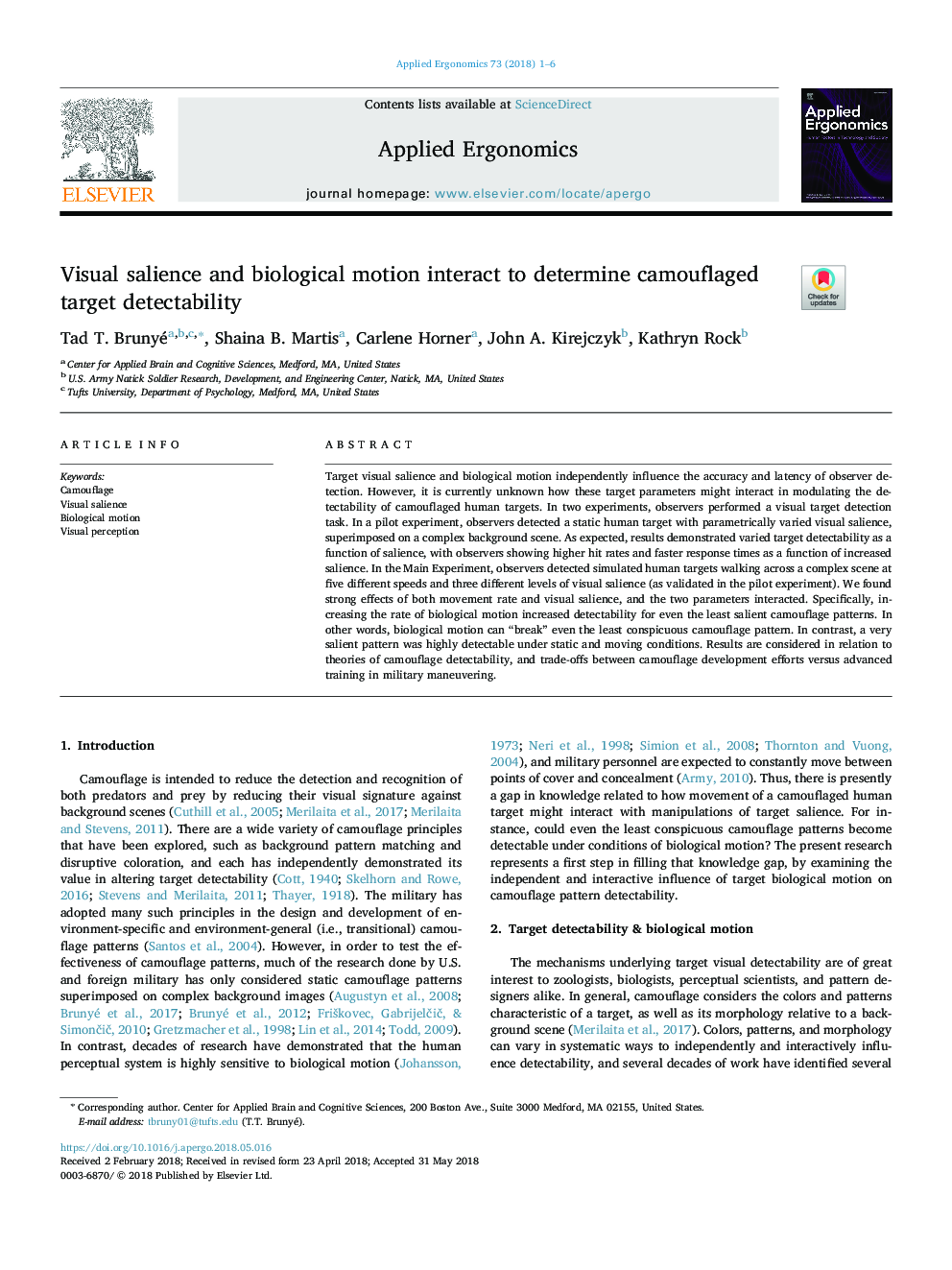| کد مقاله | کد نشریه | سال انتشار | مقاله انگلیسی | نسخه تمام متن |
|---|---|---|---|---|
| 6947538 | 1450697 | 2018 | 6 صفحه PDF | دانلود رایگان |
عنوان انگلیسی مقاله ISI
Visual salience and biological motion interact to determine camouflaged target detectability
ترجمه فارسی عنوان
سلول های بصری و حرکت بیولوژیکی برای تعیین تشخیص هدف قرار می گیرند
دانلود مقاله + سفارش ترجمه
دانلود مقاله ISI انگلیسی
رایگان برای ایرانیان
کلمات کلیدی
استتار، برجسته بصری، حرکت بیولوژیکی، ادراک بصری،
ترجمه چکیده
اهمیت بصری هدف و حرکت بیولوژیکی به طور مستقل بر دقت و تأخیر تشخیص ناظر تاثیر می گذارد. با این حال، در حال حاضر ناشناخته است که چگونه این پارامترهای هدف ممکن است در تعدیل آشکار سازی اهداف انکار شده توسط انسان تاثیر گذار باشند. در دو آزمایش، ناظران یک هدف تشخیص هدف را انجام دادند. در یک آزمایش خلبان، ناظران یک هدف انسانی ایستا با ویژگی های بصری متنوعی را که بر روی یک صحنه پس زمینه پیچیده قرار گرفته اند، شناسایی کردند. همانطور که انتظار می رفت، نتایج نشان داد که قابلیت شناسایی هدف های مختلف به عنوان یک عامل مهم است، و ناظران نشان می دهد نرخ ضربه بالاتر و زمان پاسخ سریع تر به عنوان عملکرد افزایش قابل توجهی. در آزمایش اصلی، ناظران، اهداف شبیه سازی شده انسان را در طی یک صحنه پیچیده در پنج سرعت مختلف و سه سطح مختلف بصری (همانطور که در آزمایش خلبان تایید شده بود) شناسایی کردند. ما اثرات شدید هر دو نرخ حرکت و دیدگاه های بصری را پیدا کردیم و دو پارامتر تعامل داشتیم. به طور خاص، افزایش میزان حرکت بیولوژیکی باعث افزایش قابلیت تشخیص حتی برای مدل های استتار کمتر است. به عبارت دیگر، حرکت بیولوژیکی می تواند یک شکست باشد حتی الگوی استتار کمتر قابل توجه. در مقابل، یک الگوی بسیار برجسته در شرایط ایستا و حرکت بسیار قابل تشخیص بود. نتایج در نظر گرفته شده در رابطه با نظریه های تشخیص پذیری استتار و همکاری میان تلاش های توسعه مخلوط در مقایسه با آموزش پیشرفته در مانور نظامی مورد توجه قرار گرفته است.
موضوعات مرتبط
مهندسی و علوم پایه
مهندسی کامپیوتر
تعامل انسان و کامپیوتر
چکیده انگلیسی
Target visual salience and biological motion independently influence the accuracy and latency of observer detection. However, it is currently unknown how these target parameters might interact in modulating the detectability of camouflaged human targets. In two experiments, observers performed a visual target detection task. In a pilot experiment, observers detected a static human target with parametrically varied visual salience, superimposed on a complex background scene. As expected, results demonstrated varied target detectability as a function of salience, with observers showing higher hit rates and faster response times as a function of increased salience. In the Main Experiment, observers detected simulated human targets walking across a complex scene at five different speeds and three different levels of visual salience (as validated in the pilot experiment). We found strong effects of both movement rate and visual salience, and the two parameters interacted. Specifically, increasing the rate of biological motion increased detectability for even the least salient camouflage patterns. In other words, biological motion can “break” even the least conspicuous camouflage pattern. In contrast, a very salient pattern was highly detectable under static and moving conditions. Results are considered in relation to theories of camouflage detectability, and trade-offs between camouflage development efforts versus advanced training in military maneuvering.
ناشر
Database: Elsevier - ScienceDirect (ساینس دایرکت)
Journal: Applied Ergonomics - Volume 73, November 2018, Pages 1-6
Journal: Applied Ergonomics - Volume 73, November 2018, Pages 1-6
نویسندگان
Tad T. Brunyé, Shaina B. Martis, Carlene Horner, John A. Kirejczyk, Kathryn Rock,
